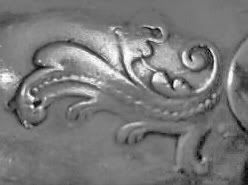First, let me say that I'm gratified to have responses to this old inquiry! Thank you for your interest!
colonial american silver can be tricky if one uses stylistic pointers to date it because there was usually a lag of a generation or more - or twenty-five or so years - between the style's appearance in europe and its assimilation into colonial america.
so if you apply that knowledge you will find that, though the style dates from 1730-1760, add twenty-five or so years - let's say thirty - and you have a date range of 1760-1790 as the earliest date at which this style might have shown itself on american soil.
I don't know that I can agree with this argument. First, the Old English form started substantially displacing the Hanoverian form in Britain in about the 1750-1770 time frame. In the late eighteenth century, in cities such as New York, Boston and Philadelphia, there were many a silversmith advertising wares "in the latest fashion", and so only a few years at most behind the leaders in London. Twenty five to thirty years behind would have American silversmiths still producing Hanoverian flatware between the Revolution and 1800. This isn't the case that I can see. And the adoption of the Fiddle Pattern in Britain and America seems to be near simultaneous, at about 1800. That said, the spoons in question are likely "provincial", that is, translated to American parlance, far away from the commerce cities cited above (or else much earlier than the proposed ~1800 date of origin).
What can be surmised without much supposition, the spoons are fashioned from hand-hammered sheet (as opposed to more automated machined-rolled sheet), the forming is somewhat crude (hence the shape differences between spoons), they are small in the original application of the concept of "tea spoon" (i.e., meant for stirring tea and not for eating anything), and the engraving is also somewhat crude. Engraving aside, maybe not the maker's doing, regardless of when made, I'm guessing these spoons were fashioned by a not terribly carriage trade smith, though the possession of the drop scroll die gives me some reservations in this assessment. So, older and metropolitan, or newer and provincial? In any event, given the form, small size and crudity, I can't see these spoons as post-1800. TIA for any opinions!
SS
.
